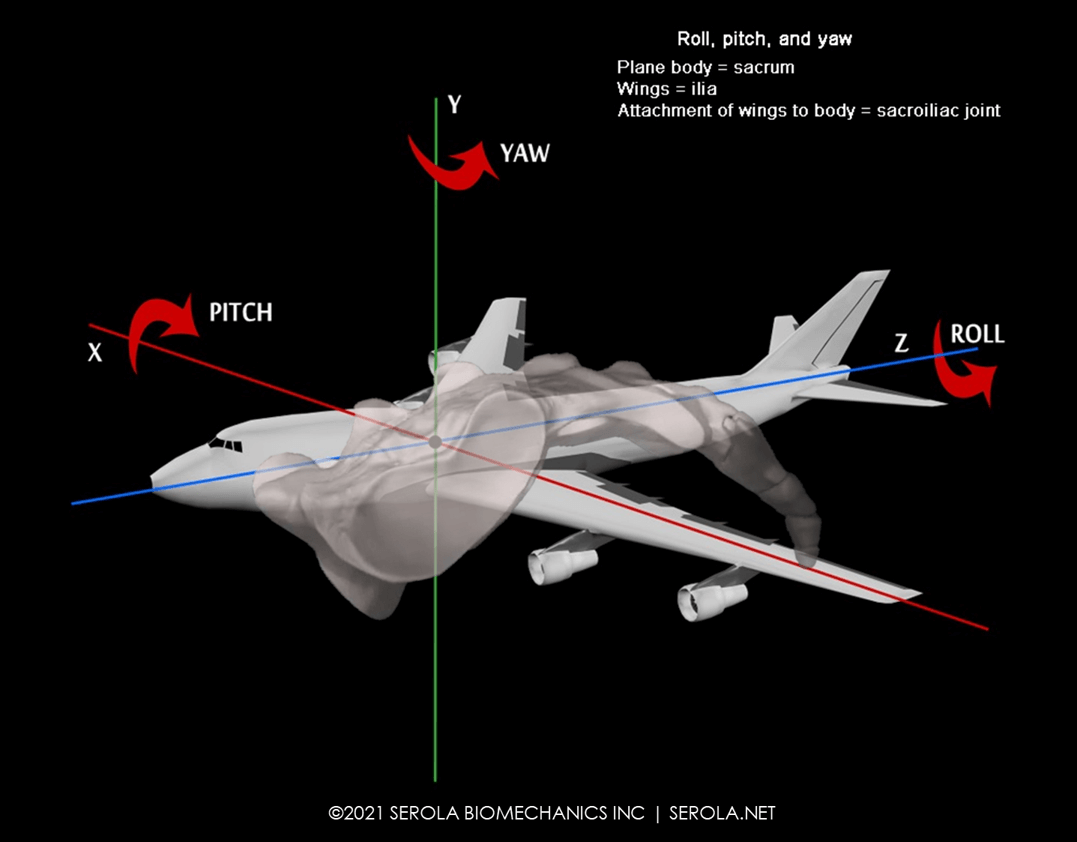Pitch, Roll & Yaw

Sacral motion can be compared to that of an airplane undergoing pitch, roll, and yaw, where sacral flexion/extension is comparable to pitch, sacral rotation is comparable to roll, and sacral lateral flexion is comparable to yaw. The combined movement around these three axes, each centered in the body of the sacrum, represents sacral motion.
The attachment of the wings to the body of the plane is comparable to the sacroiliac joint. Unlike the wings of a plane, which float freely in an open system, allowing a firm attachment to the body of the plane, the innominates are part of a closed system, which necessitates a slight amount of flexibility at their attachment to the sacrum, which is provided by the ligaments. Too much laxity will impede control and too little motion will reduce the normal pumping mechanism of the joint; either will be detrimental to stability.
The best way to visualize the movement pattern of the sacrum is to consider gait, in which sacral movement reciprocates with the ilia. In order to accommodate the two opposing iliac movements, the articular surfaces are shaped like an airplane rotor, imparting a twisting motion [1-4]. However, instead of the rotor spinning, the central body rotates, as the sacrum pivots about the prescribed paths formed into the articular surfaces of the sacrum and ilia at the sacroiliac joints, one on each side. During right nutation, the right side of the sacral base pivots anteriorly and inferiorly as the right ilium moves posteriorly and inferiorly; at the same time, the left side of the sacral base pivots posteriorly and superiorly as the left ilium moves anteriorly and superiorly. As the two ilia reverse movement, the sacrum pivots accordingly [5, 6].
References:
- Solonen, K.A., The sacroiliac joint in the light of anatomical, roentgenological and clinical studies. Acta Orthopaedica Scandinavica. Supplementum, 1957. 27(Suppl 27): p. 1-127.
- Dijkstra, P.F., A. Vleeming, and R. Stoeckart. Complex Motion Tomography of the Sacroiliac Joint and an Anatomical and Roentgenological Study. in First Intedisciplinary World Congress on Low Back Pain and Its Relation to the Sacroiliac Joint. 1992. San Diego, CA.
- Snijders, C.J., Transfer of Lumbosacral Load to Iliac Bones and Legs: Part 1 – Biomechanics of Self-Bracing of the Sacroiliac Joints and its Significance for Treatment and Exercise. Clinical Biomechanics, 1993a. 8: p. 285-294.
- Vleeming, A., et al., The role of the sacroiliac joints in coupling between spine, pelvis, legs and arms., in Movement, Stability, and Low Back Pain, A. Vleeming, et al., Editors. 1997, Churchill Livingstone. p. 53-71.
- Mitchell, F.L., Jr. and P.K.G. Mitchell, The Muscle Energy Manual. Vol. 3. 1999, East Lansing: MET Press.
- DonTigny, R.L., Critical Analysis of the Functional Dynamics of the Sacroiliac Joints as They Pertain to Normal Gait. JOM, 2005. 27(1): p. 3-10.

